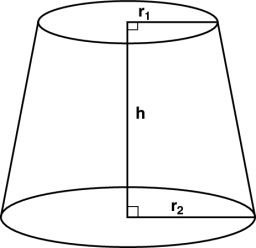Cylinder-shaped part
A truncated cone-shaped part with base radii of 4 cm and 22 cm is to be recast into a cylinder-shaped part of the same height as the original part. What base radius will the new part have?
Final Answer:

Tips for related online calculators
Looking for a statistical calculator?
Do you have a linear equation or system of equations and are looking for its solution? Or do you have a quadratic equation?
Tip: Our volume units converter will help you convert volume units.
The Pythagorean theorem is the base for the right triangle calculator.
Do you have a linear equation or system of equations and are looking for its solution? Or do you have a quadratic equation?
Tip: Our volume units converter will help you convert volume units.
The Pythagorean theorem is the base for the right triangle calculator.
You need to know the following knowledge to solve this word math problem:
statisticsalgebraarithmeticsolid geometryplanimetricsUnits of physical quantitiesGrade of the word problem
Related math problems and questions:
- Spheres to cone
 Two solid spheres of radii 2 cm and 4 cm are melted and recast into a cone of height 8 cm. Find the radius of the cone so formed.
Two solid spheres of radii 2 cm and 4 cm are melted and recast into a cone of height 8 cm. Find the radius of the cone so formed. - Frustrum - volume, area
 Calculate the surface and volume of a truncated rotating cone with base radii of 8 cm and 4 cm and a height of 5 cm.
Calculate the surface and volume of a truncated rotating cone with base radii of 8 cm and 4 cm and a height of 5 cm. - Lamp cone
 Calculate the surface of a lampshade shaped like a rotary truncated cone with a base diameter of 32 cm and 12 cm and a height of 24 cm.
Calculate the surface of a lampshade shaped like a rotary truncated cone with a base diameter of 32 cm and 12 cm and a height of 24 cm. - Katy 7
 Katy ordered a cylinder-shaped cake with a volume of 15.7 l. It consists of two layers. The volume of the upper layer is 4 times smaller than the volume of the lower layer. The height of both layers is the same and is equal to the radius of the upper laye
Katy ordered a cylinder-shaped cake with a volume of 15.7 l. It consists of two layers. The volume of the upper layer is 4 times smaller than the volume of the lower layer. The height of both layers is the same and is equal to the radius of the upper laye - Equilateral cone
 We pour so much water into a container with the shape of an equilateral cone, the base of which has a radius r = 6 cm, that one-third of the volume of the cone is filled. How high will the water reach if we turn the cone upside down?
We pour so much water into a container with the shape of an equilateral cone, the base of which has a radius r = 6 cm, that one-third of the volume of the cone is filled. How high will the water reach if we turn the cone upside down? - Container NDR
 A cone-shaped container with a bottom diameter of 60 cm and a side length of 0.5 m is filled with water. We pour the water into a container with the face of a cylinder with a radius of 3dm and a height of 20cm. Will the cylinder overflow or not be complet
A cone-shaped container with a bottom diameter of 60 cm and a side length of 0.5 m is filled with water. We pour the water into a container with the face of a cylinder with a radius of 3dm and a height of 20cm. Will the cylinder overflow or not be complet - The truncated
 The truncated rotating cone has bases with radii r1 = 8 cm, r2 = 4 cm, and height v = 5 cm. What is the volume of the cone from which the truncated cone originated?
The truncated rotating cone has bases with radii r1 = 8 cm, r2 = 4 cm, and height v = 5 cm. What is the volume of the cone from which the truncated cone originated?
